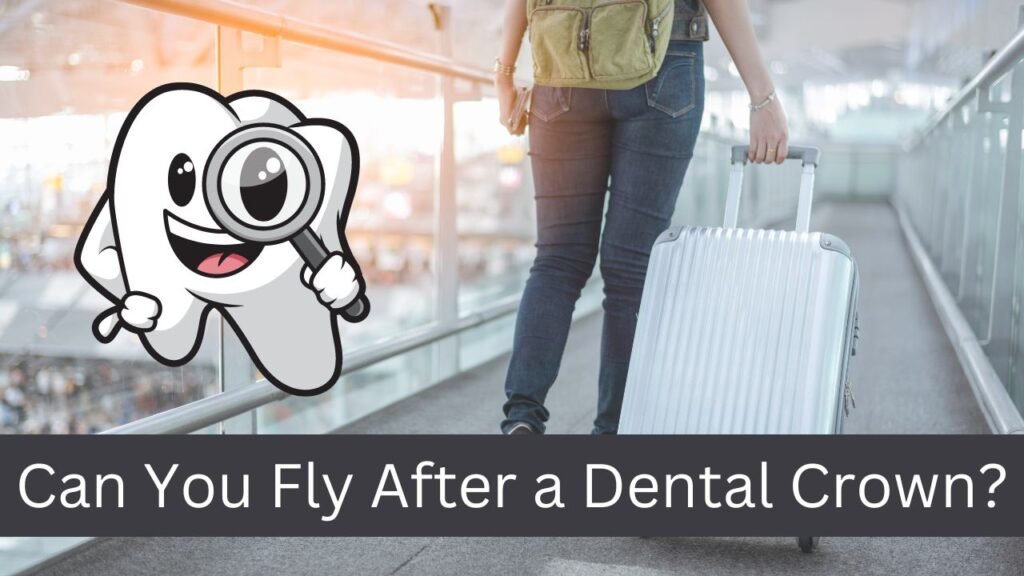Dental crowns are a common solution for restoring damaged or decayed teeth. If you’ve recently had a dental crown placed, you might wonder if it’s safe to fly.
The short answer is yes, but there are some important considerations to keep in mind. This guide will address your concerns and provide you with all the information you need for a worry-free flight.
Is It Safe to Fly After Getting a Dental Crown?

General Safety
For most people, flying after receiving a dental crown is perfectly safe. Dental crowns are designed to withstand various conditions, including the pressure changes experienced during air travel. Here’s why:
- Pressure Resistance: Crowns are securely bonded to your teeth and are not affected by the cabin pressure changes.
- Durability: They are made from materials such as porcelain, ceramic, metal, or resin, which are all robust and durable.
Exceptions
While most people can fly without issues, there are exceptions. These typically involve specific dental or health circumstances, which we’ll discuss in detail.
Important Considerations Before Flying
Healing Time
- Wait 24-48 Hours: It’s advisable to wait at least 24-48 hours after getting your crown before flying. This allows initial healing and ensures the crown has settled properly.
Temporary Crown
- Risks with Temporary Crowns: Flying with a temporary crown is not recommended due to its lower stability. Chewing pressure and air pressure changes can increase the risk of dislodgement.
Pain or Sensitivity
- Consult Your Dentist: If you experience any pain, sensitivity, or discomfort after crown placement, consult your dentist before flying. These symptoms could indicate underlying issues that need attention.
Managing Dental Anxiety
- Tips for Flying Anxiety: If you’re anxious about flying or dental work, consider distraction techniques like listening to music, watching movies, or using relaxation exercises such as deep breathing.
Managing Potential Problems During Flight
Even with proper precautions, issues can arise.
Here’s how to handle them:
Pain Management
- Over-the-Counter Relief: Mild discomfort can often be managed with over-the-counter pain relievers. Consult your dentist for specific recommendations.
Crown Dislodgement (Temporary Only)
- What to Do: If a temporary crown dislodges during your flight, try to reinsert it carefully and avoid chewing on that side. Contact your dentist as soon as possible after landing for proper reattachment.
Additional Tips for Flying After Dental Work
- Pack Essentials: Bring pain medication and a copy of your dental records in case you need to visit a dentist at your destination.
- Stay Hydrated: Drink plenty of water to maintain overall health and reduce the risk of dry mouth discomfort.
- Avoid Hard Foods: Refrain from chewing hard candy or gum, which can increase the risk of dislodging your crown.
See also: Can you fly after root canal?
Types of Dental Crowns
Understanding the types of crowns can help you feel more at ease about flying:
| Type of Crown | Description | Flying Considerations |
|---|---|---|
| Ceramic Crowns | Natural appearance, used for front teeth. | Safe for flying. |
| Metal Crowns | Made from gold or other alloys, very strong. | Safe for flying. |
| Porcelain-Fused-to-Metal | Combines aesthetics of porcelain with the strength of metal. | Safe for flying. |
| Resin Crowns | More affordable, less durable than other types. | Generally safe, but less durable. |
When to Consult Your Dentist Before Flying
Certain situations require a dentist’s advice before you take off:
- Complex Procedures: If your crown placement involved complex procedures or underlying dental issues, get your dentist’s approval before flying.
- Recent Surgery: Consult your dentist if you had recent dental surgery in addition to crown placement.
- Medical Conditions: Certain medical conditions might require clearance from both your dentist and doctor.
Conclusion
Flying after getting a dental crown is generally safe with proper precautions. Allow adequate healing time, manage any discomfort, and consult your dentist for specific guidance. Following these steps will ensure a comfortable and stress-free journey.
By following this comprehensive guide, you can confidently manage your dental health and travel plans. For more detailed advice, always consult with your dental professional. Happy flying!
Find Your Perfect Dentist
Book appointments with top-rated dentists in your area